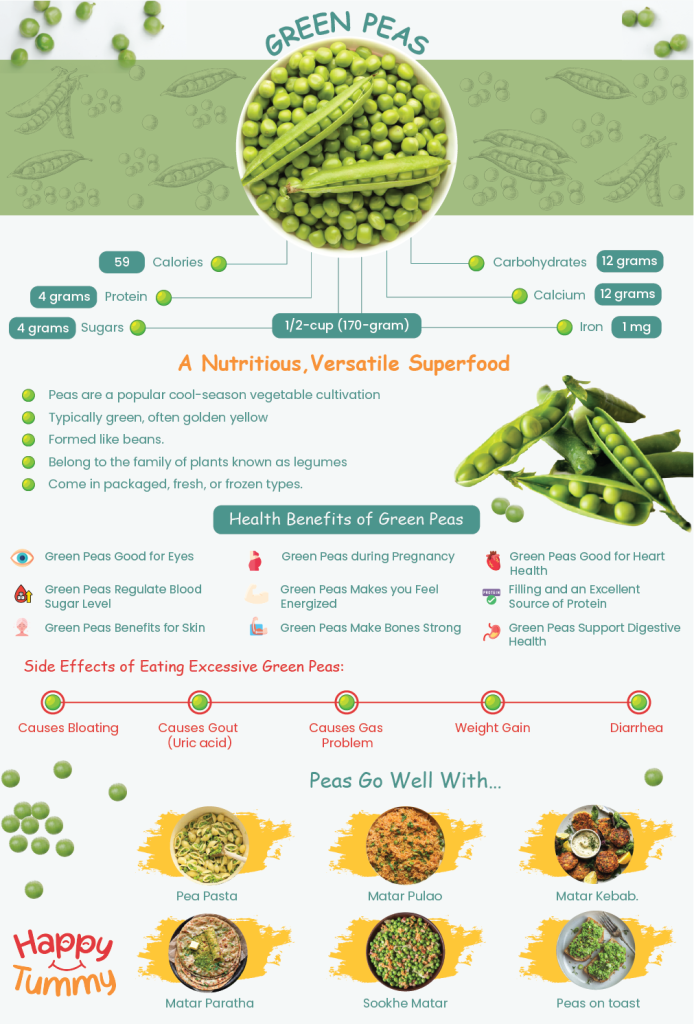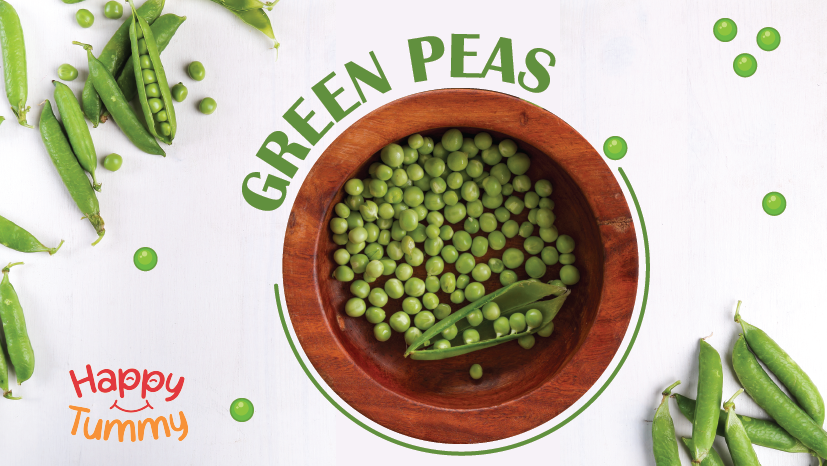Table of Contents
Raise your hand if you are a homemaker, and green peas (matar) are your go-to food when you have trouble picking what to serve for your daily meals. Be it matar paneer, matar aalu, matar pulao, methi matar, and on and on!
This is mainly owing to the fact that our freezer is the closest thing to the produce aisle, and green peas are a must in refrigerators.
What’s more impressive is that peas can add to the variety and nutrition of kids’ tiffin, significantly easing the mothers’ burden in finding a delicate balance of taste and nutrition. If I may say, green peas are the unsung heroes of the vegetable aisle.
Green peas are a great option if you want a dish that is appealing to the eye, is tasty, has a great flavour, and is also healthy.
Peas, also known as matar, are one of the most nutrient-dense foods on the earth that are neither exotic nor rare. As such, they need to be given credit for this fact.
So yes- peas are the powerhouse for all- from kids to adults!
1. About Peas
Peas are a popular cool-season vegetable cultivation that is typically green, often golden yellow, and formed like beans.
Initially, green peas were only grown during one season, but because of advances in agricultural science, they are now available all year round. They have been a staple of human diets for many centuries and are consumed all across the world.
Green peas are technically not veggies. They belong to the family of plants known as legumes (plants with seeds in pods), which make seed-producing plants that generate pods.
Legumes also include peanuts, beans, chickpeas, and lentils.
Due to their high starch content, green peas, potatoes, corn, and squash are categorized as starchy vegetables.
So green peas are frequently prepared and available for sale as vegetables. They come in packaged, fresh, or frozen types.
2. Green Peas: Powerhouse of Nutrients
The abundance of elements in green peas, including vitamins, minerals, antioxidants, and phytonutrients, has significant positive effects on your health, from protecting your eyes to preventing certain diseases.
A 1/2-cup (170-gram) serving of peas provides the following nutrients:
| NUTRIENTS | VALUE |
|---|---|
| Calories | 59 |
| Fibre | 9 grams |
| Protein | 4 grams |
| Carbohydrates | 12 grams |
| Sugars | 4 grams |
| Calcium | 21.2 mg |
| Iron | 1 mg |
The high protein level of green peas distinguishes them from other vegetables.
As an illustration, a half cup (170 grams) of cooked carrots provides only one gram of protein, whereas a half cup (170 grams) of peas has four times as much. Moreover, they contain a lot of polyphenol antioxidants, which are most likely the cause of many of their health advantages.
Green peas have a low-calorie count and are rich in antioxidants, vitamins, and minerals. They include a lot of protein and fiber as well.

3. What are the Health Benefits of Green Peas?
You must be mistaken if you believe peas are a lowly common vegetable!
These tiny gems, about the size of a bead, pack a powerful nutritional and medicinal punch. Now let’s check out the advantages of green peas for your health below:
3.1 Are Green Peas Good for Eyes?
Carrots usually receive most of the vision-boosting kudos, but peas can do much for your eyesight too.
Vitamin A, the best-known vitamin for protecting eyesight and avoiding macular degeneration (a condition affecting the central part of the retina), is found in green peas at 24 percent of the daily required level.
3.2 Green Peas Regulate Blood Sugar Level
Peas are a good addition if you need to keep an eye on your blood sugar levels because of their low glycaemic index (GI) and dietary fiber. Peas include amylose, a type of starch that delays our digestion.
As a result, researchers suggest that they may improve the stability of our sugar levels.
Moreover, peas have minerals, including magnesium, B vitamins, and vitamin C, all of which support healthy blood sugar regulation.
The American Diabetes Association suggests adding dried or canned peas to multiple meals per week for those with diabetes. They are better at controlling blood sugar levels than many other starchy foods because they have a low glycemic index.
3.3 Green Peas Makes you Feel Energized
Peas contain a lot of iron. Iron deficiency is the leading cause of anemia because it stops the body from creating enough healthy red blood cells, which carry oxygen, and causes a shortage of hemoglobin. Iron gives you power and aids in fighting fatigue.
As a result, green peas, a rich source of iron, increase your hemoglobin level and keep you energized and active.
3.4 Green Peas Support Digestive Health
A few servings of green peas in your diet can do wonders for your tummy because they are low in calories and high in protein and fiber.
One cup of green peas has 5 grams of dietary fiber, which is up to 35% of your daily requirement.
More high-fiber foods in your diet can improve your health in several ways, particularly when it comes to digestion. When ingested frequently, peas improve digestive fire enzymes and decrease unnecessary waste.
As fiber travels through the digestive system, it gives stool volume, which helps to promote regularity by increasing the frequency of bowel movements. Thus peas improve food digestion and aid in removing toxic waste from your body.
3.5 Green Peas Good for Heart Health
Peas contain heart-friendly minerals, including magnesium, potassium, and calcium. They are also rich in antioxidant nutrients like vitamin C and phytonutrients, including carotenoids and flavonols, which are heart protective and support cardiovascular function.
The soluble fiber included in peas aids in controlling cholesterol levels, particularly LDL cholesterol.
3.6 Filling and an Excellent Source of Protein
Green peas are among the finest plant-based providers of protein, and that, together with their high fiber content, is a crucial factor in why they are so nourishing.
When you consume protein, your body produces more specific hormones that suppress hunger. Along with fiber, protein slows digestion and increases feelings of fullness.
By controlling your appetite, eating enough protein and fiber can automatically lower the number of calories you consume throughout the day.
The exceptional protein concentration of green peas makes them a superb food option for those who do not consume animal products. So go green with green peas!
3.7 Green Peas Benefits for Skin
You must eat foods that promote collagen (a kind of protein) formation if you want healthy skin. Our skin and hair are made healthy by the collagen protein in our bodies.
High protein levels in green peas help the body produce more collagen and prevent the signs of aging of the skin.
Moreover, collagen keeps skin smooth and elastic and prevents it from wrinkling. Green peas also include a significant amount of vitamin C and other antioxidants, which help maintain our skin’s health.
Further, green peas also constitute compounds like flavonoids, tannins, epicatechin, carotenoid, and alpha-carotene that minimize fine lines and blemishes.
3.8 Green Peas during Pregnancy
According to a US Department of Agriculture on children’s health, a pre-pregnancy diet must include peas. Pregnant women must ingest 300 more calories daily; thus, they must eat foods that are high in different vitamins and minerals.
Green peas are advantageous for expectant mothers since they are an excellent source of protein, iron, and calcium. Besides that, they contain a lot of proteins. Women who are pregnant need to eat enough foods that are high in protein or vitamin B.
3.9 Green Peas Make Bones Strong
Iron and zinc, two minerals abundant in green peas, help sustain the density and strength of bones.
The most significant fact is that one cup of green peas provides almost 44% of the daily recommended amount of vitamin K, which is essential for creating healthy bones. Moreover, green peas are abundant in the mineral phosphorus, which strengthens bones.
4. Downsides of Eating Excessive Green Peas
However, the saying “too much of a good thing is bad” also applies to peas. Green pea consumption in excess can be harmful to your health. Below are a few negative effects of eating too many green peas.
4.1 Bloating
Green pea overconsumption can result in uncomfortable abdominal bloating.
Green peas that have not been cooked include several antinutrients, such as lectin and phytic, which can cause bloating, gas, and farts.
4.2 Gout (Uric acid)
Eating excessive amounts of green peas can also lead your body to shed calcium and produce excessive uric acid, which can aggravate gout. A painful disorder known as gout occurs when uric acid accumulates in the joints.
Although having a small amount of uric acid in your blood is normal, having too much can be dangerous to your health.
4.3 Gas Problem
The carbohydrate content is high in green peas. Overeating peas can cause problems like gas, cramping, and burping. However, the peas still have these flaws even after being thoroughly cooked.
As a result, eating only a small amount of peas is recommended.
4.4 Diarrhoea
Green pea overconsumption can also cause diarrhoea and irritable bowel syndrome. This is due to the actual protein content peas have.
Eat green peas with rice and soy sauce to prevent the negative effects of eating too many peas.
5. Peas Go Well With…
Peas enjoy pairing up with other vegetables to create nutrient-dense dishes. They enjoy pairing up with fruit and vegetables with intense flavours, such as lemons, asparagus, mushrooms, onions, and fennel, as well as soybeans, which are high in protein, lettuce and spinach, which are both high in iron and other minerals.
Peas are incredibly adaptable and pair excellently with various herbs and spices, including mint, black pepper, curry, sunflower oil, basil, garlic, and parsley.
This makes them ideal in breezy summer salads and full curry meals, which are fantastic for the warmer months. Pea and mint salad is our absolute favourite; yum!
Now that we are all masters in the realm of culinary mingling let’s look at various recipes that include peas.
With your newly acquired understanding of flavour combinations, you may entirely customize the following to your preferences and be sure to impress your guests!
5.1 Pea Pasta
Uncomplicated yet delicious classic. Peas go great in just about every pasta recipe, so we love to put them in!
Peas are a staple in pasta, magi and noodles, and many other dishes.
5.2 Peas-On-Toast
Move over mayonnaise, peas on toast are one of our favorites. You read it right. Consider spreading them on toast with some olive oil, crushed, and salt & pepper to taste.
You can change it by adding pepper or chili flakes from your cabinet. Fast, simple, and nutritious!
5.3 Matar Pulao
Nothing beats this straightforward rice dish flavored with mushy green peas and spice mixes—the perfect rice dish for lunch.
5.4 Matar Paratha
Matar Paratha is one of the vintage culinary delights of all time. Whether served with white butter, green chutney, or pickles, the matar-stuffed paratha tastes delicious.
The traditional Indian food for brunch, lunch, and dinner is sizzling hot parathas.
5.5 Peas Pattice
Matar pattice are crunchy, cooked tikkis that are loaded with a range of items, including potatoes, coconut, dry nuts like cashew nuts and peanuts, seasonings, and peppers. They make the ideal crunchy and flavorful evening treat.
5.6 Sookhe Matar
When hunger hits, reach for them as the ideal between-meal munch filled with the flavors of spices such as asafetida, parsley, and mango powder.
A quick, simple, and wholesome snack that you may eat in large quantities.
5.7 Matar Kebab
Crispy, flavorful, and full matar kebabs loaded with spinach’s health benefits and spices and chilies, will surely satisfy your taste buds. This recipe for perfectly fried kebabs is ideal for making quickly home on a rainy day with a mug of tea.
Has this motivated you to start cooking?
Hence, don your aprons and get ready to prepare since peas are for exploration, fun, and nutrition. Overall, adding green peas to your diet is a really healthy choice.
Frequently Asked Questions
Peas are a common allergy because they are a legume. If you have been told that you are allergic to legumes, which can include soy and peanuts, you should take extra care.
Green peas have a three to four-day shelf life on average. They primarily grow during the winter for about five months. Moreover, they are frequently stored in deep refrigerators with the use of dehydration processes to fulfill the demand year-round.
People in good health can occasionally eat a few frozen peas without getting sick. In fact, it’s a fantastic method to increase your intake of vegetables, and they are the perfect summertime snack. The best option is to make sure you consume a lot of vegetables every day, whether fresh, packaged, or frozen.
Before eating, they must be prepared, often by rehydrating and boiling in hot water. The outer pods of peas, specifically those that are mainly young and tender, can be eaten raw (think sugar snaps), but as peas age, their outer pods become stiff and rough, making them less enjoyable to chew on. So they should be cooked before consumption.
According to the USDA, green peas have 244 mg of potassium per 100 grams, which lowers blood pressure in people with diabetes. Due to their low glycaemic index (GI) and good dietary fiber, peas are a valuable supplement to monitor your blood sugar levels. Peas include amylose, a carbohydrate that slows down our digestion. They thus increase the stability of sugar levels.















